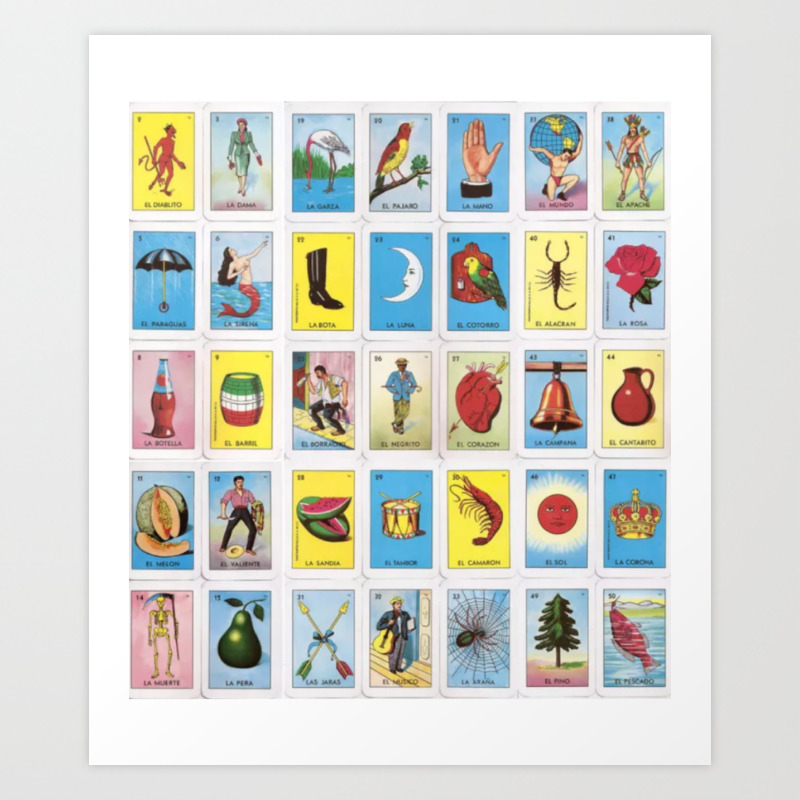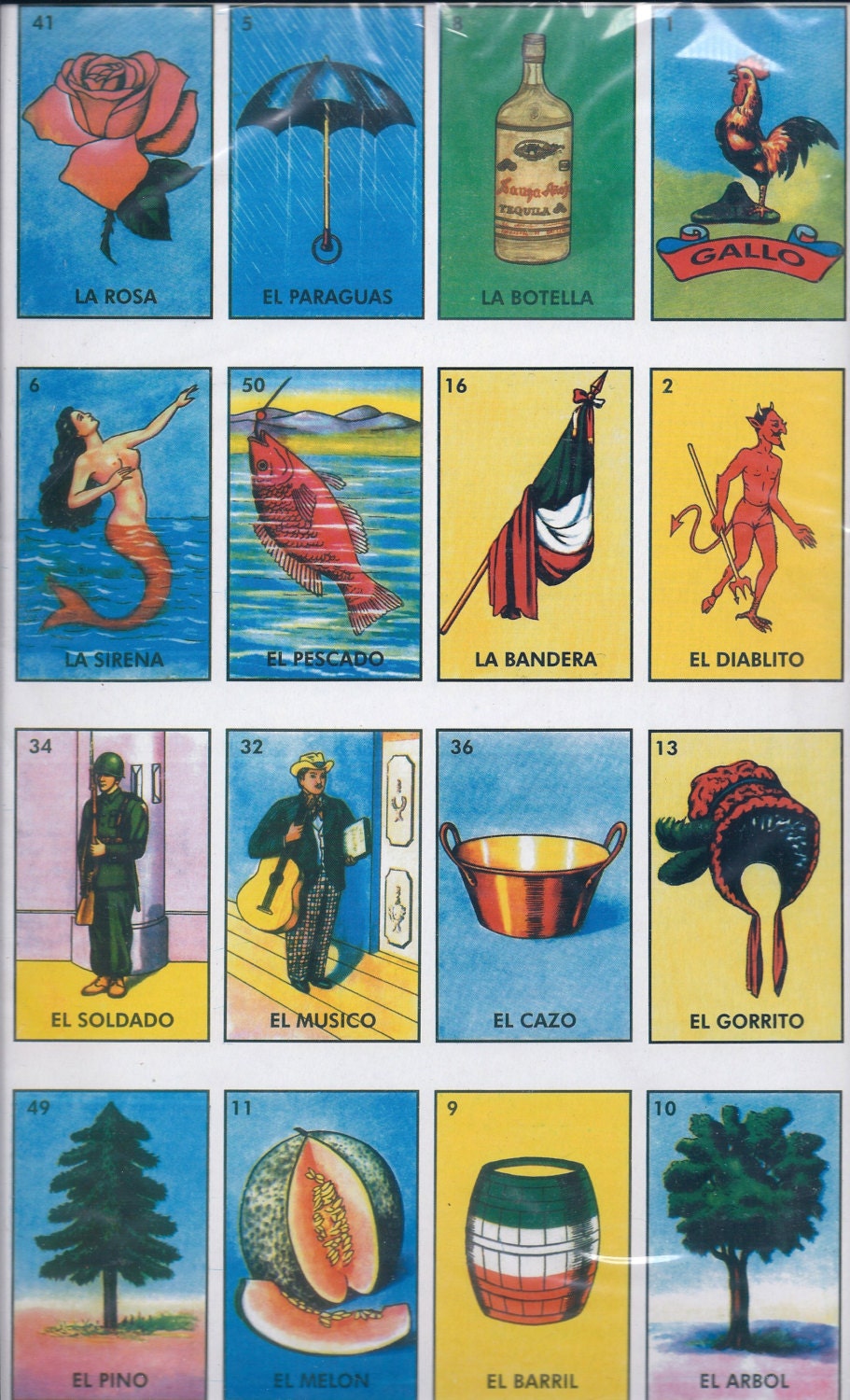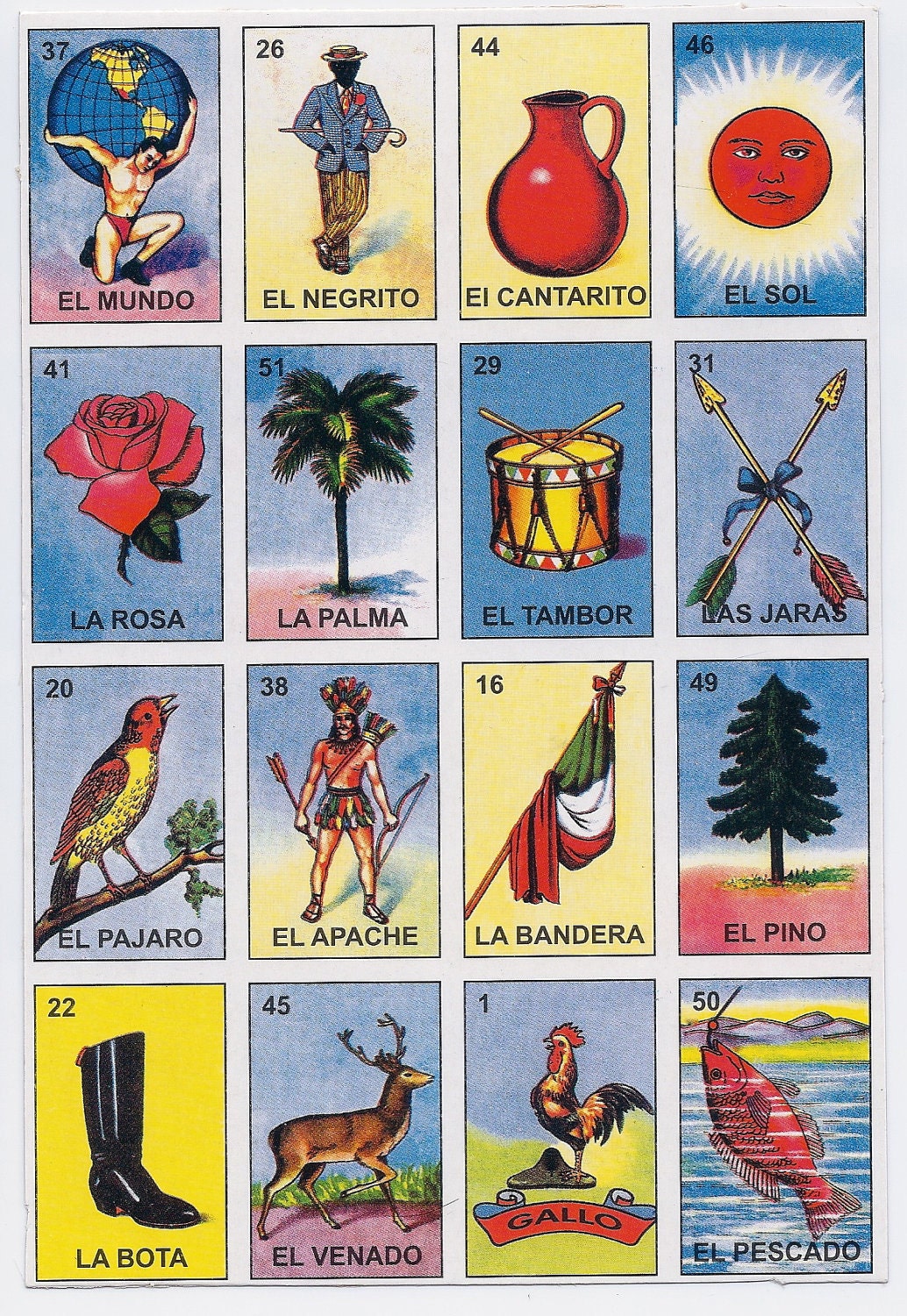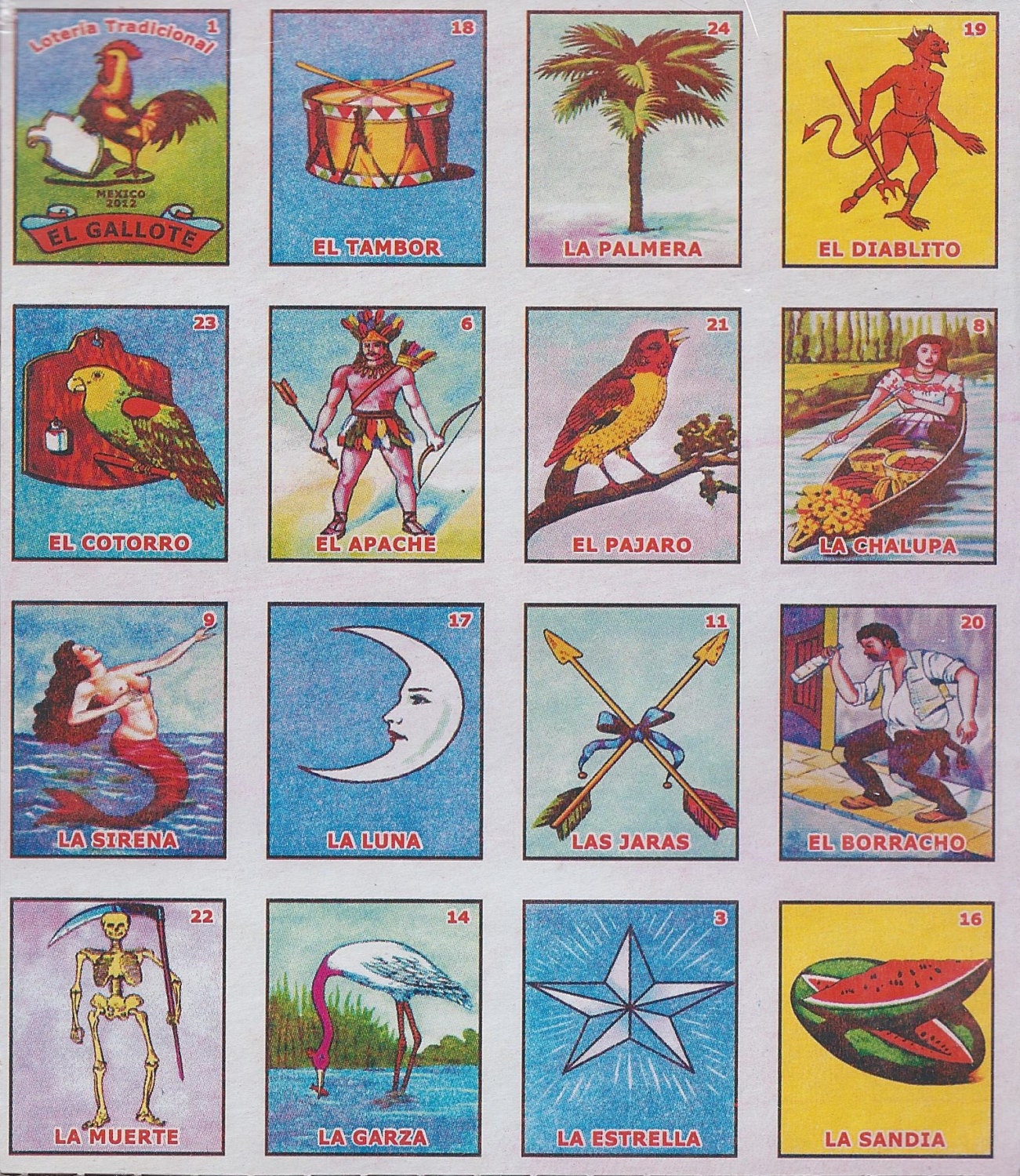Loteria Mexican Bingo

American Bingo Board and Mexican Loteria Tabla The game is very similar to American Bingo, with some differences. In Bingo, a number with an associated letter is randomly chosen from a rotating drum, while in Loteria, with a colorfully illustrated image is drawn from a special deck of 54 cards. For a truly authentic Fiesta or Cinco de Mayo party game, we suggest our classic Loteria Mexican Bingo. This game is played like regular bingo, except you cover up the spaces on your playing card based on the traditional Mexican images drawn from a deck of cards. This game is sure to be a big hit! In this lesson, students will learn about the history of the famous Mexican bingo game, Loteria and use the game to learn different vocabulary words commonly used in the Spanish language. This a fun way to improve the vocabulary of students as well as learn more about the Mexican culture! MexicoHistoryLa Loteria, A Mexican Bingo Game.pdf.
Mexican Bingo Cards Printable
What is the Mexican bingo called?
Bingo games that are famous throughout the world turned out to have different names in certain countries. Let's take an example from Mexico. This country has a unique name on bingo, Loteria. The word Loteria is a Mexican word that means lottery. What makes it interesting about this Loteria game is that although it is a bingo game, the card used is very unique and different from the bingo cards that we know.
Are Loteria cards Tarot cards?
Loteria cards are cards that consist of pictures and also numbers. But the numbers are often not used as in the commonly known bingo cards. Loteria cards are more focused on the pictures that are on the card. Loteria cards consist of interesting pictures. Because the beginning of the maker of Loteria cards was an artist and this game was once a game played by people who are respected. Some images on Loteria cards have similarities to tarot cards such as sun, moon, star, angel, and devil. But Loteria cards cannot be used as tarot cards because of a few cards, right? Tarot cards have more detail than Loteria, even though they have several of the same card names.
How do you make a Mexican bingo card?
To be able to make interesting Mexican bingo cards, you need to know what images are on each card. The number of cards that Mexican bingo cards have is 54 cards. So you have to complete all 54 images. You can make it by searching for templates or printables from Mexican bingo cards provided on the internet. Usually, the template and the printable all the cards have become one package, so you do not need to search for images on the card one by one. After that, you just need to print and cut it to the size of the Mexican bingo cards.

How many people can play Loteria at once?
As with every game, there are a number of players who are concerned when playing it. If it consists of too many players, it will be difficult to solve it. And if it consists of too few players, the game becomes unpleasant. Loteria, also known as Mexican bingo cards also has a limit on the number of players. In one game, Loteria can be played by a maximum of 10 people. If you and your friends consist of more than 10 players, you can take turns playing each other by playing more than one round. Sounds fair, right.
More printable images tagged with:
| Other name(s) | Mexican bingo[1] |
|---|---|
| Language(s) | Spanish |
| Random chance | High |
| Material(s) required | cards |
Lotería is a traditional game of chance, similar to bingo, but using images on a deck of cards instead of numbered ping pong balls. Every image has a name and an assigned number, but the number is usually ignored. Each player has at least one tabla, a board with a randomly created 4 x 4 grid of pictures with their corresponding name and number. Players choose a tabla to play with, from a variety of previously created tablas, each with a different selection of images.
Lotería is the Spanish word for lottery. The deck is composed with a set of 54 different cards with a picture on it. To start, the caller (cantor, or singer) shuffles the deck. One by one, the caller picks a card from the deck and announces it to the players by its name, sometimes using a verse before reading the card name. Each player locates the matching pictogram of the card just announced on their board and marks it off with a chip or other kind of marker. In Mexico, it is traditional to use small rocks, crown corks or pinto beans as markers. The winner is the first player that shouts '¡Buena!' right after completing a tabla or a previous agreed pattern: row, column, diagonal or a pozo.
Lotería de Pozo is a variant version of the traditional Mexican Lotería, where the basic rules apply. For this version, before the game begins, players agree on how many pozos are to be completed in a row, column or diagonal pattern. A Pozo is a group of images in a square. The square may contain 2 x 2 (4) or 3 x 3 (9) images[2] for a traditional tabla.
Loteria online game[3] is a game to allow computer users to play an online a version of the Lotería Mexicana. It was created in 1996.[3]
History[edit]

The origin of lotería can be traced far back in history. The game originated in Italy in the 15th century and was brought to New Spain (modern Mexico) in 1769. In the beginning, lotería was a hobby of the upper classes,[1] but eventually it became a tradition at Mexican fairs.
Don Clemente Jacques began publishing the game in 1887.[1] The current images have become iconic in Mexican culture, as well as gaining popularity in the US and some European countries. Other popular Lotería sets are Lotería Leo, Gacela and Lotería de mi tierra.
During the 1930s, the Catholic church came up with their own version of la Lotería. It consisted of Catholic images instead of the traditional images used in the original game. The Catholic church did this to promote their beliefs by making their very own game board similar to the Lotería.[1]
Cards and associated verses[edit]
The following is a list of the original 54 lotería cards, traditionally and broadly recognized in Mexico. Below each card name and number, are the verses (in Spanish) sometimes used to tell the players which card was drawn. However, there are several less traditional sets of cards, depicting different objects or animals.

1 El gallo ('the rooster')
2 El diablito ('the little Devil')
3 La dama ('the lady')
4 El catrín ('the dandy')
5 El paraguas ('the umbrella')
6 La sirena ('the mermaid')
7 La escalera ('the ladder')
8 La botella ('the bottle')
9 El barril ('the barrel')
10 El árbol ('the tree')
11 El melón ('the melon')
12 El valiente ('the brave man')
13 El gorrito ('the little bonnet')
14 La muerte ('Death')
15 La pera ('the pear')
16 La bandera ('the flag')
17 El bandolón ('the mandolin')
18 El violoncello ('the cello')
19 La garza ('the heron')
20 El pájaro ('the bird')
21 La mano ('the hand')
22 La bota ('the boot')
23 La luna ('the moon')
24 El cotorro ('the parrot')
25 El borracho ('the drunkard')
26 El negrito ('the little black man')
27 El corazón ('the heart')
| 28 La sandía ('the watermelon')
29 El tambor ('the drum')
30 El camarón ('the shrimp')
31 Las jaras ('the arrows')
32 El músico ('the musician')
33 La araña ('the spider')
34 El soldado ('the soldier')
35 La estrella ('the star')
36 El cazo ('the saucepan')
37 El mundo ('the world')
38 El Apache ('the Apache')
39 El nopal ('the prickly pear cactus')
40 El alacrán ('the scorpion')
41 La rosa ('the rose')
42 La calavera ('the skull')
43 La campana ('the bell')
44 El cantarito ('the little water pitcher')
45 El venado ('the deer')
46 El Sol ('the sun')
47 La corona ('the crown')
48 La chalupa ('the canoe')
49 El pino ('the pine tree')
50 El pescado ('the fish')
51 La palma ('the palm tree')
52 La maceta ('the flowerpot')
53 El arpa ('the harp')
54 La rana ('the frog')
|
Google tribute[edit]
On December 9, 2019, Google celebrated Lotería with a Google Doodle.[4] The interactive game has the El Apache, El borracho, El diablito, El gorrito, La muerte, El negrito, El soldado, and El valiente cards replaced with El ajolote ('the axolotl'), El buscador ('the search engine'), La concha ('the conch'), El elote ('the fresh ear of corn'), El emoji ('the emoji'), El gorro ('the cap'), El guacamole ('the guacamole'), and El xoloitzcuintle ('the hairless dog').[citation needed] Artworks for La sirena and El guacamole cards not found during the game can still be seen in the background of the end screen.

References[edit]
- ^ abcdVillegas, Teresa. 'History of La Lotería'Archived 2017-01-16 at the Wayback Machine, www.teresavillegas.com
- ^'Lotería de Pozo'. www.maravillasoftware.com. Archived from the original on 2018-11-17. Retrieved 2018-10-20.
- ^ ab'How the Loteria Mexicana / Mexican Bingo became an online game?'. Maravilla Software. Archived from the original on 2019-06-13. Retrieved 2019-06-21.
- ^'Celebrating Lotería!'. Google. 9 December 2019. Archived from the original on 9 December 2019. Retrieved 9 December 2019.
Further reading[edit]
- Lotería: A Novel, by Mario Alberto Zambrano
- Playing Lotería: El Juego de La Lotería, by René Colato Laínez
- El Arte de la Suerte, by Artes de Mexico Número 13, Otoño 1991, Nueva Época
External links[edit]
- Media related to Lotería (board game) at Wikimedia Commons
- Software to print Lotería: Loteria Workshop
- Lotería de pozo : Another way to play lotería
- Rules and pictures(in Spanish)